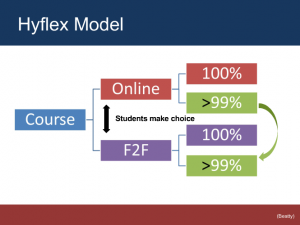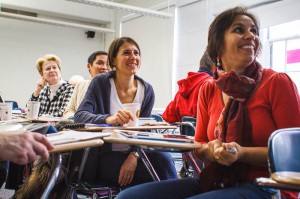Blended learning — the combination of traditional teacher-led classroom instruction and independent student learning outside the classroom using online materials — has been an exciting evolution and a perrenial “hot topic” within the education landscape. Though the idea only became fully conceptualized about 10 years ago, with some calling it instead “hybrid learning,” initial efforts began long before. The MMLC led some of Northwestern’s earliest efforts in the mid 1990s in French and German language programs with the launch of Le Français Internautique and Intermatik. In French, grammar and listening comprehension activities shifted into an online space. Contact hours could then focus on topics requiring face-to-face discussion, even allowing for a possible reduction in class meetings. In German, online components provided students with valuable online resources that complimented their normal in-class time. In each case, students appreciated greater control over how and when they learn.
Taking a Better Look at Blended Learning
The broad definition of what constitutes “blending,” has led to the concept’s now seemingly ubiquitous usage. Nearly every Northwestern course could be considered blended; most already satisfy the definition by simply using Blackboard or a similar course management system to distribute educational materials for independent learning outside the classroom. Yet, even if blending is automatic, a better understanding of blended learning components and opportunities can assist in developing an optimal pedagogy.
In March, the MMLC invited faculty to participate in an EDUCAUSE Learning Initiative (ELI) videoconference seminar, “Looking for the Pedagogy in Blended Course Design” led by Patricia McGee, Associate Professor University of Texas at San Antonio. Representing NU were Richard Lepine (PAAL), Franziska Lys (German), Ana Williams (Spanish & Portuguese) and MMLC Director Katrin Völkner. Although the full proceedings will not be available until mid June, select details and resources from the event are already available online:
http://www.educause.edu/eli/events/eli-online-seminar/march-2013
In talking about blended approaches, the seminar focused on four main topics: (1) identifying practices that fit with course priorities, (2) adapting an ideal strategy for blending, (3) using a learner-centered approach, and (4) identifying student needs specific to blended learning.
Best Practices for Blending
After having made meta analyses, McGee identified a unified intersection of best practices. The first of these is the adherence to a phased approach. For example, if starting from a course with largely face-to-face interaction, McGee suggests taking at least two steps to reach a stage where (if desired) no course content is covered in class. First, enable the blend by making technology and resources available to replicate the same resources used in class outside of class. Then, enhance the blend by incorporating subtle changes to the pedagogy such as including supplementary material online. Finally, in a third phase, a transforming blend requires learning outcomes be met by using the out-of-class resources to actively construct knowledge.
When imagining the design of a blended course, best practice suggests focusing first on course objectives before deriving course activities, assignments, and assessments. Then, as McGee suggests, evaluating these objectives one by one can inform content delivery decisions — should a topic be presented online or in class? — and also inform the pedagogy whose role includes bridging the online and in-class activities.
A common pitfall in embracing blended learning is the “course-and-a-half” phenomenon. This occurs when online elements are added to traditional courses without removing or streamlining the existing areas of the course. Overall, this creates more work for both students and and instructors, and leads to decreased satisfaction. Designing blended courses from scratch can provide the best opportunity to avoid such problems but it is not often feasible or possible to locate the necessary resources and time (as much as 3 to 6 months) for a complete redesign. Instead, the course must be incrementally moved online, enhanced, and streamlined.
Pedagogical Strategy for Blending
McGee acknowledged that pedagogical design for a blended course is both the most important and most challenging task. Integration of the online and in-class activities is key for the online learning to have the most relevance and is too often overlooked in blended courses. What one does in and outside the classroom must be connected. But what should be done in these areas?
With more of the core learning occurring outside the classroom, there are opportunities for formal and informal approaches to class meetings. Formal activities might include workshops, coaching, mentoring, lecturing, debate, or active learning tasks such as group work, problem-solving, simulations, case studies, or role-playing. Informal activities might include creating small group conferences, ad-hoc work teams to work on self-directed investigations of problems, or as an opportunity to engage in self-directed active learning tasks.
Blended learning also offers additional opportunities for student assessment which McGee recommends be done thoughtfully and intentionally. Online assessment should be, in her view, reserved for low-stakes assessment: quizzes, assignments, essays. High stakes assessment (exams, tests, presentations) should be reserved for the face-to-face environment.
Additional activities best suited to the classroom also include giving advice, clarifying muddy points, peer-led discussions, peer debriefing, collaborative work, and reinforcing social presence.
Learner-Centeredness
One of the great strengths of blended learning is its ability to put greater responsibility and control of the learning in the hands of the learner. By making the learning process more directly relevant to the learner, goals for greater and longer-lasting learning outcomes can be met.
McGee suggests active learning tasks are essential to any learner-centered design, and offers three different ways of organizing active learning tasks: Process, Product, and Project. The process-driven approach focuses on the completion of smaller isolated or progressive activities, such as fieldwork, audio recording, concept mapping, peer review, and gaming. The product-oriented approach focuses on a defined end-product that, when completed, will demonstrate the learner’s command of the course material. These more complex products might include essays, and podcasts. In most cases, group work is required for a project-oriented approach where completed activities and assignments fit into a mutually understood list of course objectives. Examples of these learning interactions might include debates, shared blogs, and other online group collaboration.
Technology decisions can have an impact on the success of active learning tasks. Often, technology is employed for asynchronous communication: forums, e-mail, blogs. Yet, whether to recommend or require students collaborate in synchronously, in real-time, or asynchronously can have effects on mental engagement. Asynchronous modes can support a deeper understanding through time-intensive questioning or problem solving. By contrast, synchronous activities can also include valuable mentoring and peer review activities. In short, both activity types have value and should be included in a blended design.
Identification of Student Needs
If a learner-centered model is valuable, equally important is an understanding of students’ changing needs. Students today are “born digital” and, with this background, have a greater proclivity to consume information visually rather than textually. And yet since much of blended learning courses still tend to place tremendous value on text and text-based communication, the highest levels of engagements might be missed if the blended content does not also evolve.
Similarly, even though they are “digitally native,” recent students often do not always have the proper background to perform well in blended courses. When considering how to prepare students for blended courses, McGee identified eight predictors of success:
- self-regulation
- self-management
- ability to be emotionally engaged
- adaptable identity (e.g. a grad student expected not to be the expert)
- realistic expectations of time & effort
- high academic achievement
- comfort with eLearning
- technological know-how
The first three of qualities receive particularly strong emphasis because they are essential to an active learning space, while comfort with eLearning and technological know how, while important, rate highly among the learner’s extant capacities. For blended learning to succeed, development of good behaviors can and should receive special attention in early, foundation courses.

A depiction of the HyFlex learning model developed by Brian Beatty of San Francisco State University (presentation slide from McGee’s EDUCAUSE presentation)
To help students prepare for blended courses, one unique approach is the “HyFlex” model, first introduced at San Francisco State University by Brian Beatty. In the HyFlex model students choose a main “home” interaction setting of either face-to-face or online, but after this, they are locked-in to neither. Each student can select either method of participation weekly, according to their needs. This system appears best suited to larger, multi-section courses as it requires that the two versions of the course, online and in-class, remain constantly in sync.
The MMLC and Blended Learning — We are Here to Help
With a long and accomplished history of blended course resource development behind it, the MMLC is ready to help faculty learn more about blended learning and how it assist in the associated curricular development of your courses. Although we live in a technology-enabled and blended world, we’ll be happiest to meet face-to-face. We invite you to email mmlc@northwestern.edu to set up an appointment or to obtain more information.
